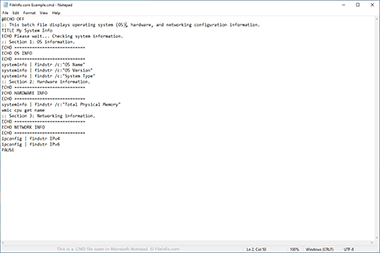.CMD File Extension
Windows Command File
| Developer | Microsoft |
| Popularity |
4.2 | 191 Votes |
What is a CMD file?
More Information
CMD files were introduced in the early 1990s with the release of Windows NT and can still be run by later Windows operating systems. The scripts are often created to perform repetitive tasks that require multiple steps, such as opening and converting a file in a program, creating a backup of a file, or setting the computer to sleep at a certain time.
You can run the commands stored in a CMD file in Windows by double-clicking the file or executing it in the Command Prompt (CMD.EXE) utility. You cannot run CMD files in COMMAND.COM, like you may do with BAT files, so that you do not incorrectly execute commands in the wrong Windows environment.
To run a CMD file in Command Prompt you must first navigate to the location of the CMD file, then press "Enter." For example:
C:\Path_to\The_folder\Example.cmd
Since CMD files store commands in plain text format, they can be opened and edited with a text editor, such as Notepad or Wordpad. You can also create your own CMD scripts with a text editor by adding one or more commands on separate lines and saving the file as a CMD file. Make sure the filename has a .cmd file extension instead of a .txt file extension.
Warning
Since CMD files store executable commands, they can be used to distribute and execute malware attacks. For example, malicious CMD files may delete users' data or crash users' systems. To protect against malware attacks, do not double-click a CMD file you have downloaded or received via email unless you trust the file's source. If you want to verify the commands a CMD file contains, you can open the file in a text editor and examine its contents. If the file appears unsafe, delete it.
Programs that open CMD files
M.U.G.E.N Character Commands File
| Developer | Elecbyte |
| Popularity |
3.2 | 49 Votes |
Game file used by M.U.G.E.N, a free game engine used for creating 2D fighting games; saves the command set for a character, which defines what actions are taken when receiving keyboard input from the user; specifies when to kick, punch, jump, or take another action.
